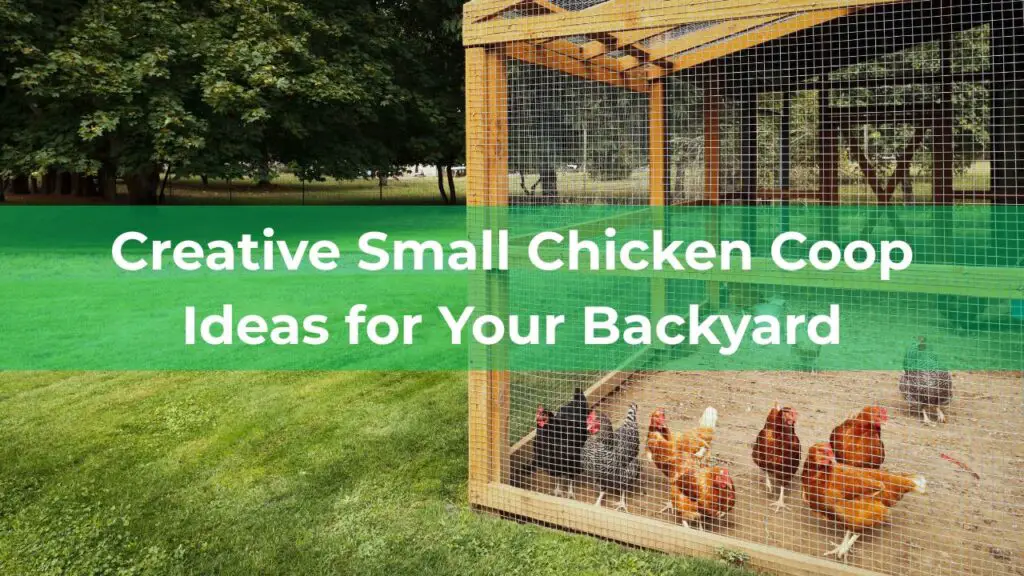Small gardens can be charming and functional, offering a slice of nature even in limited spaces. Whether you’re looking to create a cozy retreat or a productive nook for herbs and veggies, there are plenty of creative solutions to make the most out of your small outdoor area. Let’s jump right into some inspiring ideas that can help you turn any tiny patch into a delightful garden!
Raised Bed Gardening Solutions
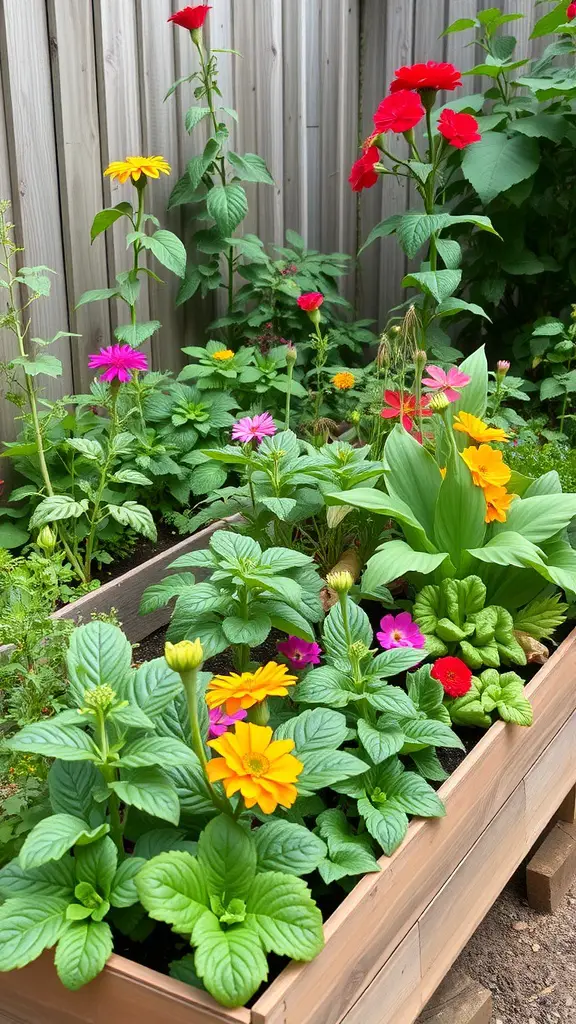
Raised bed gardening is a fantastic way to maximize space and create a vibrant garden. The image shows a beautifully arranged raised bed filled with a variety of colorful flowers. This setup not only looks great but also makes gardening easier.
In a raised bed, plants are elevated, which improves drainage and soil quality. The flowers in this bed, like the bright red and yellow blooms, add a cheerful touch to any small garden. You can mix different types of plants to create a lively display.
Raised beds also help keep weeds at bay and can be easier to maintain. They are perfect for small spaces, allowing you to grow flowers, herbs, or even vegetables. With a little creativity, you can turn any small area into a flourishing garden.
Utilizing Vertical Space with Shelving
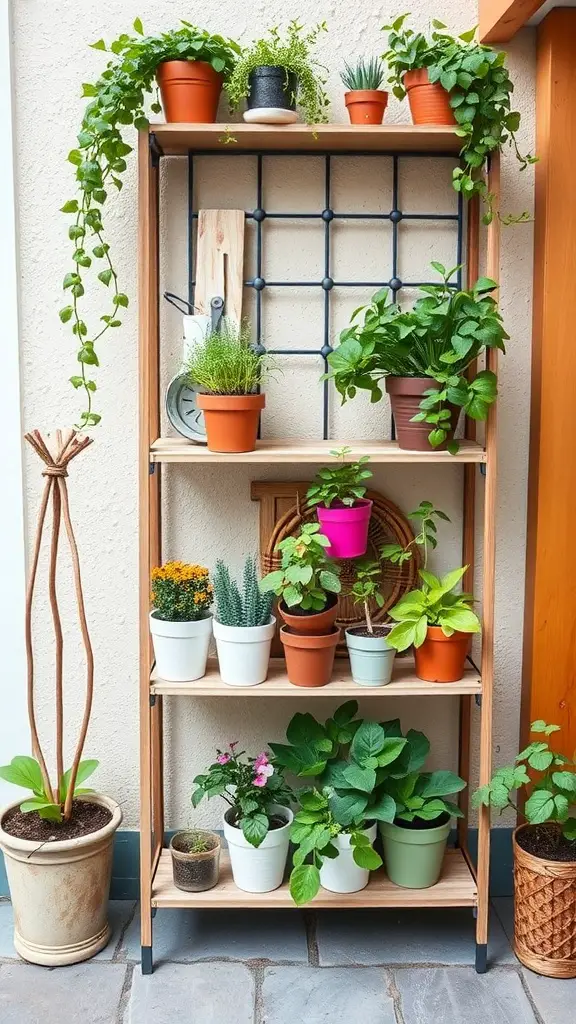
Vertical gardening is a fantastic way to maximize your small garden space. A well-structured shelving unit can transform a plain wall into a vibrant display of plants. In the image, we see a beautifully arranged shelf filled with various potted plants, showcasing how effective this method can be.
The shelves are stacked neatly, allowing for different heights and types of plants. From trailing vines to small succulents, each plant adds its unique charm. The use of colorful pots brings a playful touch, making the garden feel lively and inviting.
Not only does this setup save ground space, but it also creates an eye-catching focal point. The greenery against the neutral wall enhances the overall look of the area. This idea is perfect for anyone looking to bring a bit of nature into a compact space.
Incorporating shelving into your garden design can also make plant care easier. Having plants at eye level allows for better maintenance and watering. Plus, it’s a great way to showcase your favorite plants while keeping everything organized.
Succulent Arrangements for Small Areas
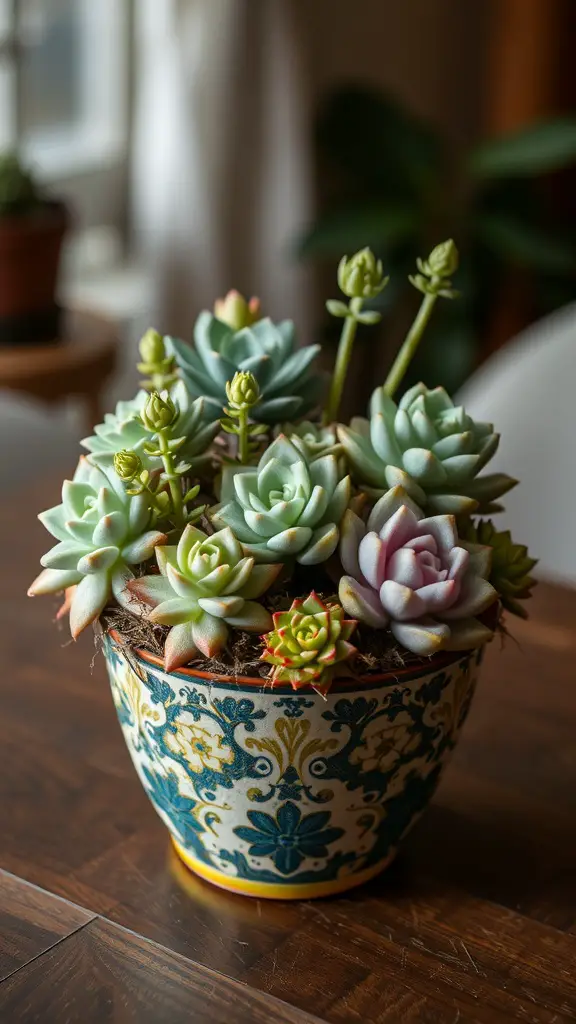
Succulents are perfect for small spaces. They come in various shapes and colors, making them a fun choice for any garden. In the image, you see a beautiful arrangement of succulents in a decorative pot. The pot adds a pop of color and style, enhancing the overall look.
These plants are low-maintenance and thrive in minimal water, making them ideal for busy lifestyles. You can place them on a windowsill, a small table, or even a shelf. Their unique forms create visual interest without taking up much room.
Mixing different types of succulents can create a stunning display. Consider combining rosette shapes with taller varieties for depth. Grouping them together in a single pot, like in the image, gives a cozy feel and makes a statement.
Don’t forget to choose a pot with good drainage. This helps prevent overwatering, which is key to keeping your succulents healthy. With a little creativity, you can turn any small area into a charming green space!
Creative Use of Wall Planters
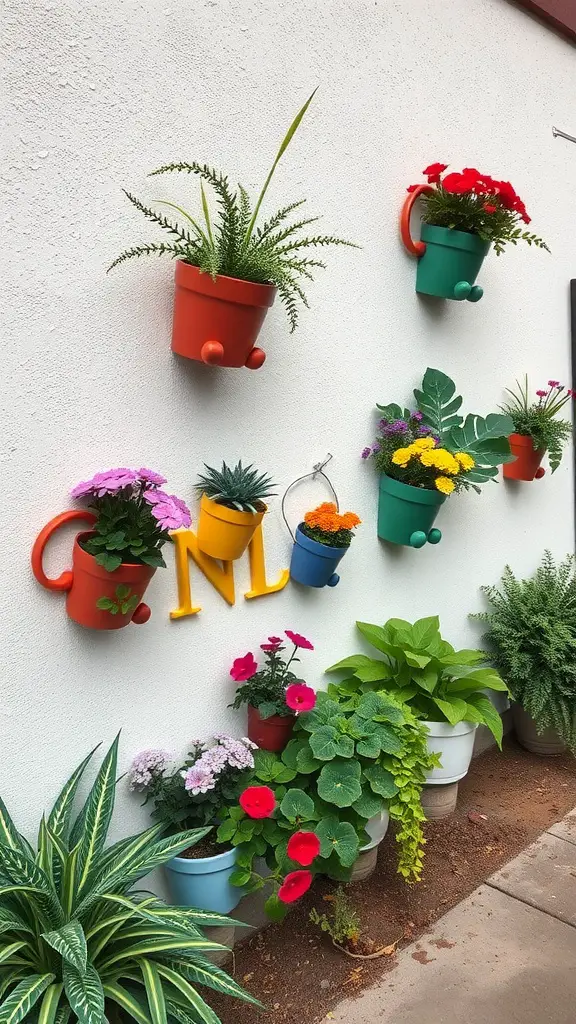
Wall planters are a fantastic way to bring life to small spaces. This image showcases a vibrant display of colorful pots attached to a wall, each filled with various plants. The arrangement is playful and eye-catching, making it a perfect example of how to utilize vertical space effectively.
The pots come in different colors, adding a cheerful touch to the wall. Some are filled with bright flowers, while others feature lush greenery. This mix creates a lively atmosphere that can brighten up any area, whether it’s a balcony, patio, or even indoors.
Using wall planters not only saves ground space but also allows for creative designs. You can arrange the pots in various patterns or shapes, making your garden unique. Plus, they can be easily changed out with the seasons, keeping your space fresh and interesting.
Incorporating wall planters into your garden design is a simple way to enhance your outdoor or indoor space. They invite nature into your home while adding a personal touch. So grab some pots, pick your favorite plants, and start creating your own vertical garden!
Vertical Gardening Techniques
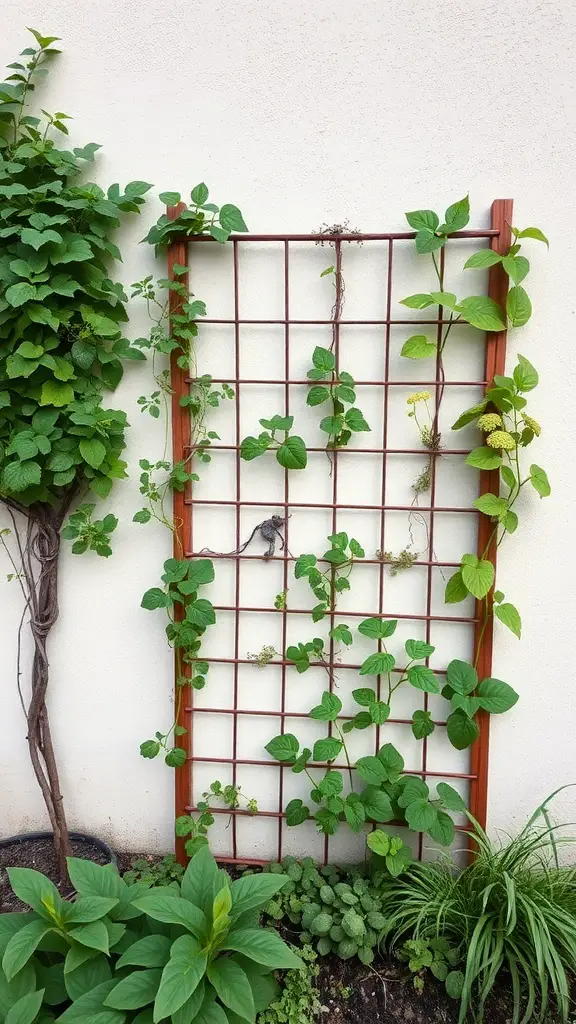
Vertical gardening is a fantastic way to make the most of limited space. The image shows a trellis adorned with climbing plants, showcasing how you can utilize vertical space effectively. This method not only adds greenery but also creates a beautiful focal point in your garden.
The trellis in the image is a simple yet effective structure. It supports various climbing plants, allowing them to grow upwards rather than outwards. This technique is perfect for small gardens where floor space is at a premium. You can easily install a trellis against a wall or fence, making it a versatile option for any garden layout.
Incorporating vertical gardening techniques can also improve air circulation around your plants, helping to prevent diseases. Plus, it makes harvesting easier since you can reach your plants without bending down. Whether you choose to grow flowers, herbs, or vegetables, vertical gardening can enhance your gardening experience.
Container Gardening for Limited Spaces
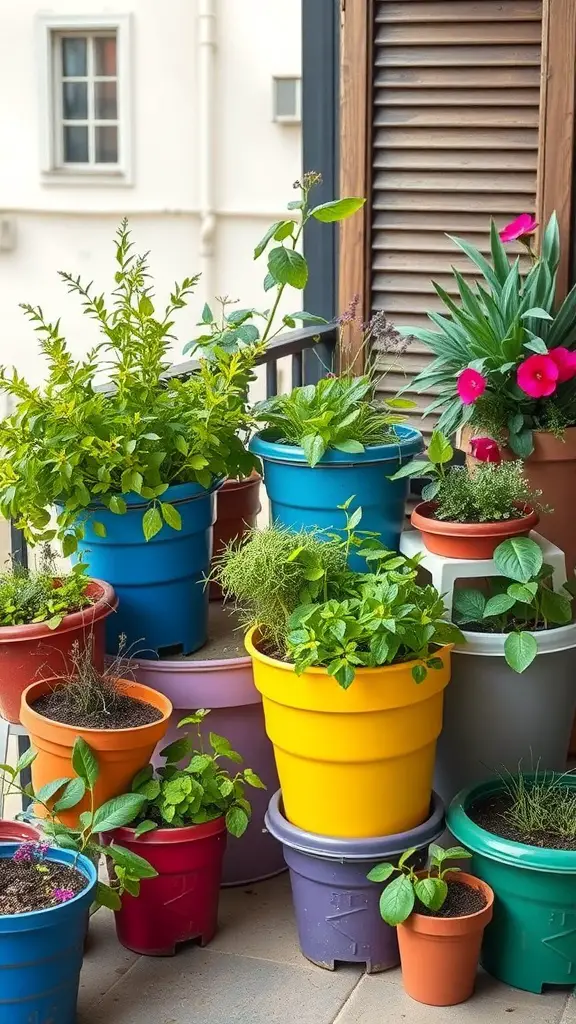
Container gardening is a fantastic way to make the most of small spaces. The image shows a vibrant collection of potted plants, each in colorful containers. This arrangement not only adds charm but also maximizes the use of limited areas like balconies or patios.
Using containers allows you to grow a variety of plants, from herbs to flowers, without needing a large garden. You can easily move pots around to catch the sun or shade, depending on what your plants need. Plus, the bright colors of the pots bring a cheerful vibe to any space.
When choosing plants, consider what you enjoy using in your kitchen or what flowers make you smile. Herbs like basil and mint thrive in pots and can be used in cooking. Flowers like petunias and marigolds add beauty and attract pollinators.
Don’t forget to ensure proper drainage for your containers. Adding a layer of stones at the bottom can help with this. With a little creativity and care, your small space can become a lush garden.
Garden Pathways to Maximize Space
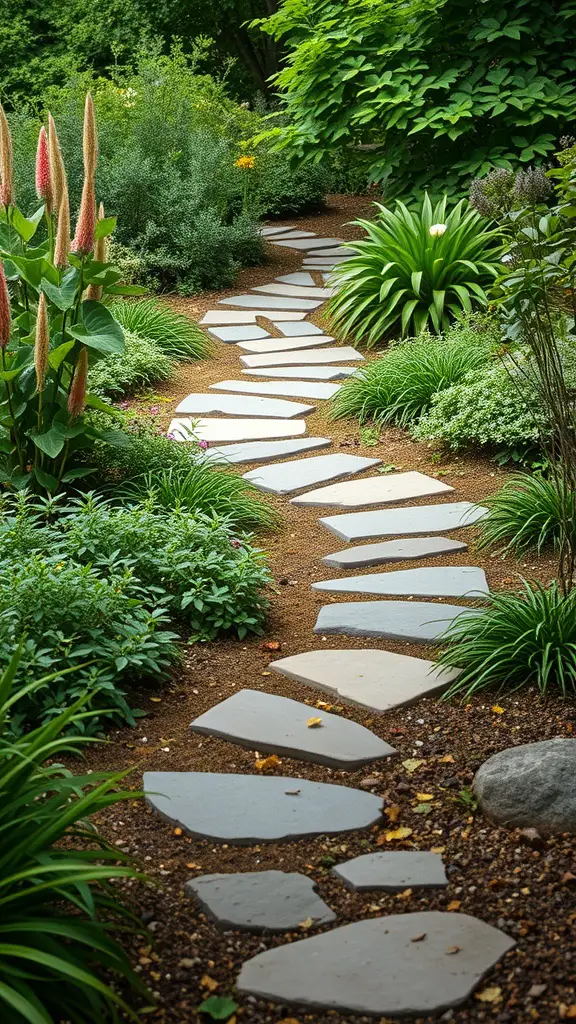
Creating pathways in a small garden can really open up the space. The image shows a charming stone path winding through lush greenery. This design invites you to explore every corner of the garden.
Using stepping stones like those in the picture not only adds visual interest but also helps define the pathway. It keeps your feet clean and makes it easier to navigate through the plants.
Consider using materials that blend well with your garden’s natural look. The stones here are a great choice, providing a nice contrast to the surrounding plants. This can enhance the overall appeal of your garden.
Pathways can also serve practical purposes. They help prevent soil compaction around your plants and keep weeds at bay. Plus, they create a clear route for watering and maintenance.
Incorporating curves into your pathway design can make the garden feel larger. Straight paths can feel rigid, while a winding path adds a sense of flow. This design choice can make your small garden feel more expansive.
Miniature Herb Gardens
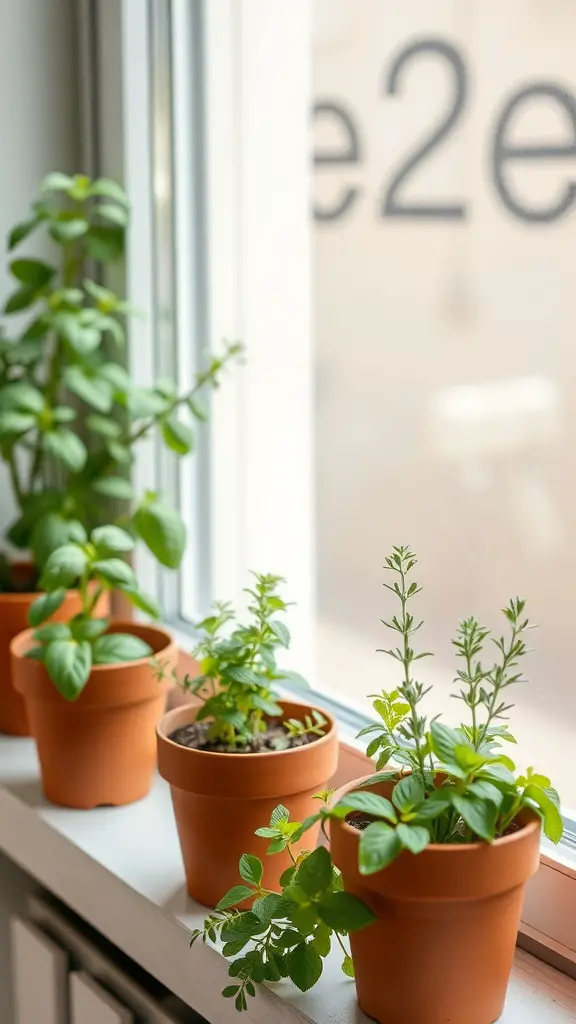
Miniature herb gardens are a fantastic way to bring fresh flavors into your kitchen. They fit perfectly in small spaces, making them ideal for apartments or cozy homes. The image shows a lovely row of potted herbs on a windowsill, showcasing the beauty of greenery indoors.
These little pots can hold a variety of herbs like basil, mint, and thyme. Each plant adds its unique touch, both visually and in terms of aroma. Growing herbs at home means you can easily snip off a few leaves whenever you need them for cooking.
Setting up your own miniature herb garden is simple. Start with small terracotta pots, good potting soil, and your favorite herb seeds or seedlings. Place them in a sunny spot, and watch them thrive. Regular watering and occasional trimming will keep them healthy and productive.
Not only do these gardens look great, but they also provide a sense of accomplishment. Plus, there’s nothing quite like using fresh herbs in your meals. It’s a small step towards a more sustainable lifestyle.
Using Trellises for Climbing Plants
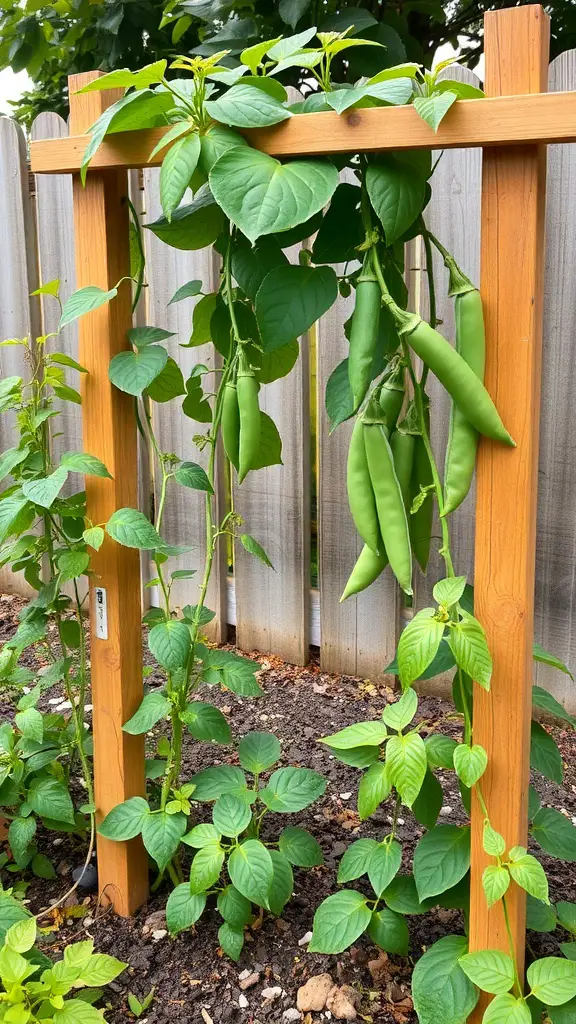
Trellises are a fantastic addition to any small garden, especially for climbing plants. They provide support and allow plants to grow upwards, saving valuable ground space. In the image, you can see a sturdy wooden trellis supporting lush green vines and plump pea pods. This setup not only looks great but also maximizes the garden’s productivity.
Climbing plants like peas, beans, and cucumbers thrive when given something to cling to. The trellis creates a vertical garden that can be both functional and beautiful. As the plants grow, they create a green wall that adds depth and interest to your garden.
Using a trellis also makes harvesting easier. You can reach the produce without having to bend down or dig through the soil. Plus, it helps with air circulation, reducing the risk of disease. If you’re short on space, a trellis is a simple solution to enhance your gardening experience.
Water Features for Tranquility
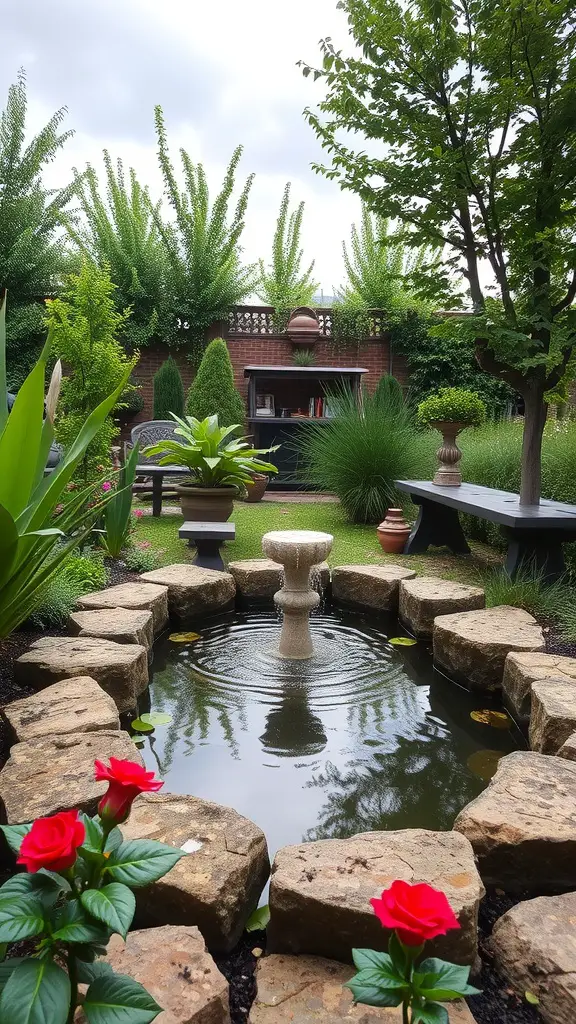
Water features can truly transform a small garden into a peaceful retreat. In the image, a charming fountain sits at the center of a serene pond, surrounded by smooth stones. The gentle ripples in the water create a calming effect, inviting you to pause and enjoy the moment.
Bright red roses bloom nearby, adding a splash of color and enhancing the garden’s beauty. The lush greenery around the pond complements the water feature, making it feel like a natural oasis. This setup not only provides a visual treat but also offers soothing sounds that can help you unwind.
Incorporating a water feature like this can be a simple yet effective way to enhance your garden. Whether it’s a small fountain or a pond, the presence of water brings life and tranquility to your outdoor space. Imagine sitting by this pond, listening to the water flow, and enjoying the fresh air. It’s a perfect spot for relaxation or reflection.
Incorporating Edible Plants in Small Gardens
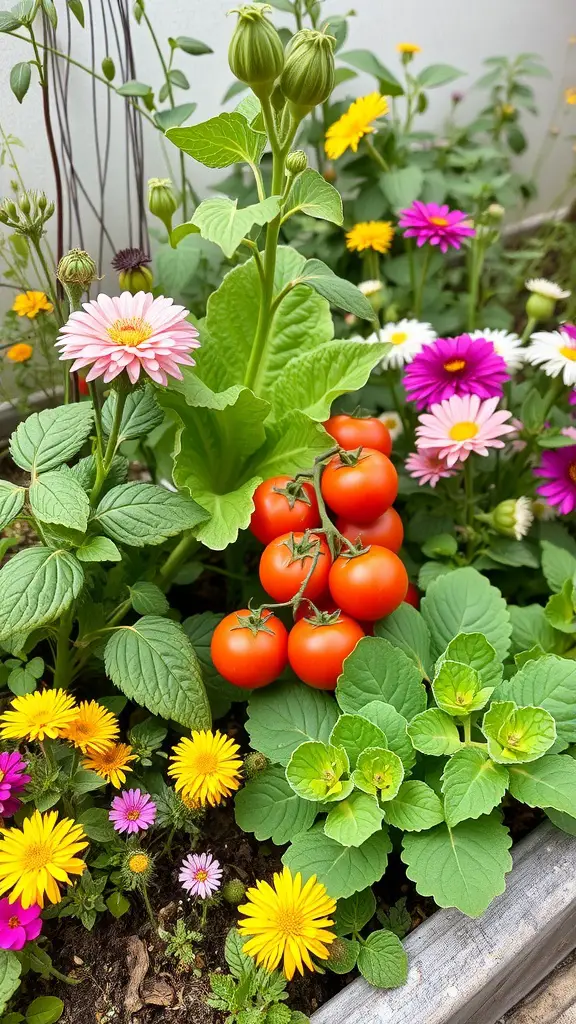
Small gardens can be a delightful mix of beauty and practicality. Imagine a vibrant space filled with colorful flowers alongside fresh, juicy tomatoes. This combination not only looks great but also provides delicious ingredients for your meals.
In the image, we see a lovely arrangement of blooming flowers, such as pink and yellow daisies, surrounding a cluster of ripe tomatoes. This setup showcases how you can easily blend ornamental plants with edible ones. The bright colors of the flowers create a cheerful atmosphere while the tomatoes add a touch of homegrown goodness.
When planning your small garden, think about incorporating herbs and vegetables that thrive in limited space. Options like basil, lettuce, and peppers can grow well alongside flowers. This way, you can enjoy a beautiful garden and fresh produce right at your fingertips.
Creating a small garden with edible plants is not just practical; it also encourages a connection to nature. Watching your plants grow and eventually harvesting them can be a rewarding experience. So, grab some seeds, get your hands dirty, and start planting!
Creating a Pollinator-Friendly Space
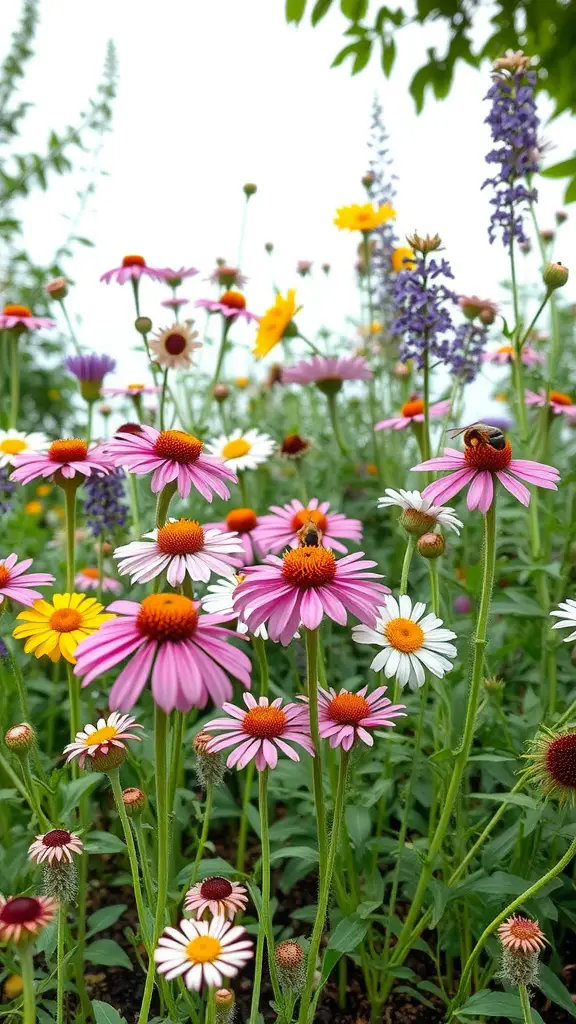
Creating a pollinator-friendly garden is a fantastic way to support local wildlife. The image showcases a vibrant array of flowers, including daisies and coneflowers, which are perfect for attracting bees and butterflies. These colorful blooms not only brighten up your garden but also provide essential food sources for these important pollinators.
To start, consider planting a variety of native flowers. Native plants are well-adapted to your local environment and tend to attract more pollinators. Grouping flowers in clusters makes it easier for bees and butterflies to find them. The image highlights how different flower types can coexist beautifully, creating a lively and inviting space.
Don’t forget about the importance of providing water and shelter. A small birdbath or shallow dish can serve as a water source. Adding some rocks or twigs can create resting spots for insects. This simple addition can enhance the habitat for pollinators, making your garden a buzzing hub of activity.
Incorporating Garden Art and Decor
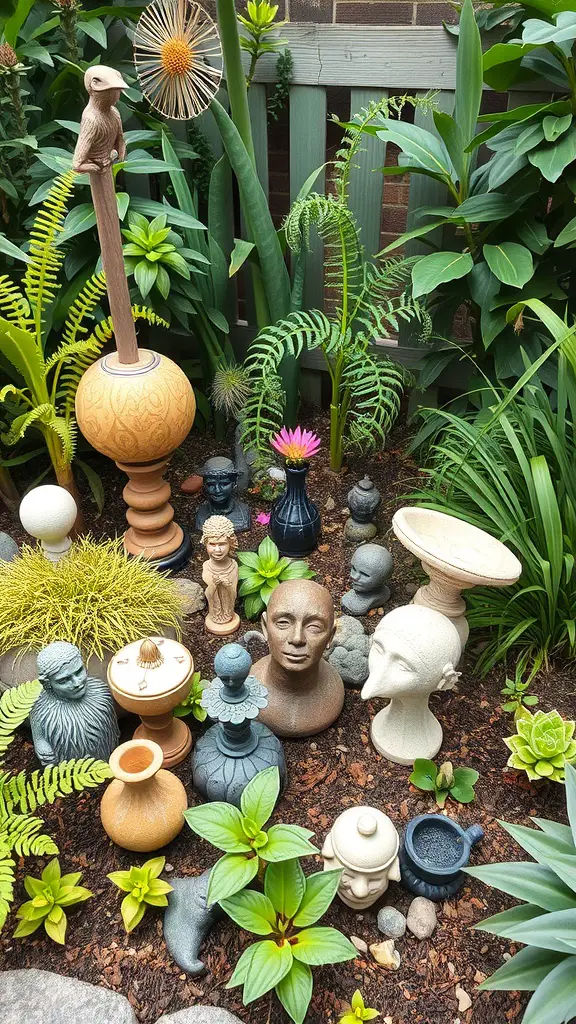
Adding art and decor to your small garden can make it feel unique and inviting. The image shows a lovely arrangement of various decorative pieces nestled among lush greenery. Each item adds character, creating a delightful focal point.
From whimsical sculptures to elegant planters, these elements can transform a simple space into a charming retreat. Notice the playful bird statue standing tall, drawing the eye upward. It’s a great way to add height and interest to your garden.
The variety of textures and colors in the decor complements the plants beautifully. The mix of stone, ceramic, and wood materials creates a harmonious look. Consider using similar styles to tie everything together.
Don’t forget about smaller details, like the tiny pots and figurines scattered throughout. They invite curiosity and encourage exploration. Even in a small garden, these little touches can make a big impact.
So, whether you’re drawn to modern art or classic statues, find pieces that resonate with you. Your garden should reflect your personality and style, making it a true extension of your home.
Seasonal Flower Displays
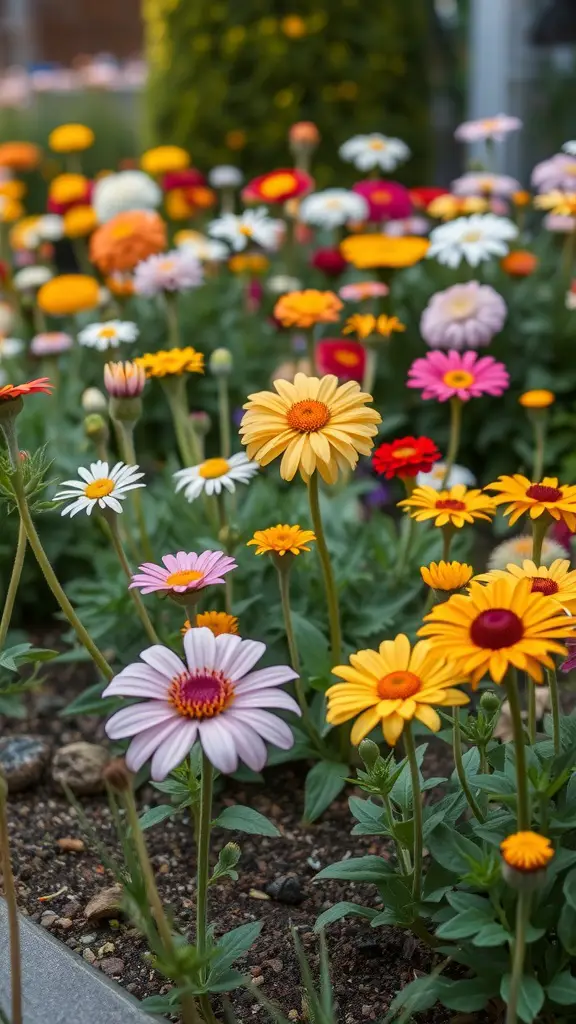
Seasonal flower displays can truly brighten up any small garden. Imagine a burst of colors with daisies, marigolds, and other cheerful blooms. These flowers not only add beauty but also attract butterflies and bees, making your garden lively.
In spring, you can start with vibrant daisies and cheerful marigolds. They thrive in sunny spots and are easy to care for. As summer rolls in, consider adding zinnias and sunflowers for a splash of warmth. Their bold colors can create a stunning visual impact.
Don’t forget about fall! You can incorporate chrysanthemums and asters to keep the garden looking fresh. These flowers offer rich hues that complement the changing leaves. With careful planning, you can have a garden that showcases seasonal beauty all year round.
Using Colorful Mulch for Aesthetic Appeal
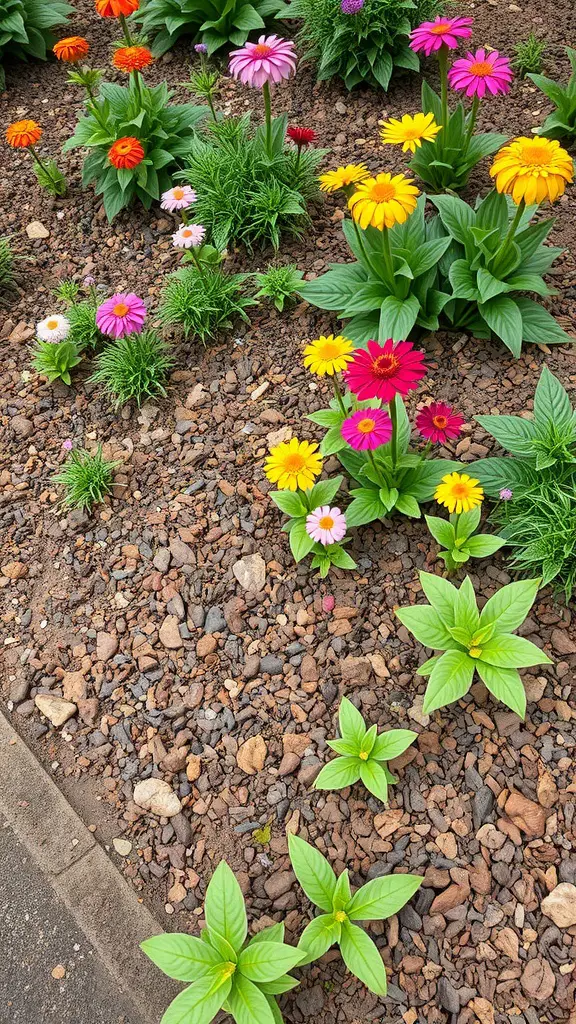
Colorful mulch can really brighten up a small garden. In the image, you can see a lovely arrangement of flowers surrounded by rich, earthy mulch. The vibrant colors of the flowers pop against the natural tones of the mulch, creating a cheerful and inviting space.
Using mulch not only enhances the look of your garden but also helps with moisture retention and weed control. The contrast between the flowers and the mulch adds depth and texture, making the garden feel more dynamic. You can choose from various mulch colors to match your personal style or the theme of your garden.
In this setup, the flowers are in full bloom, showcasing shades of pink, yellow, and orange. This mix of colors draws the eye and creates a lively atmosphere. Pairing colorful mulch with bright flowers can transform even the smallest garden into a vibrant retreat.
Incorporating Ground Covers for Low Maintenance
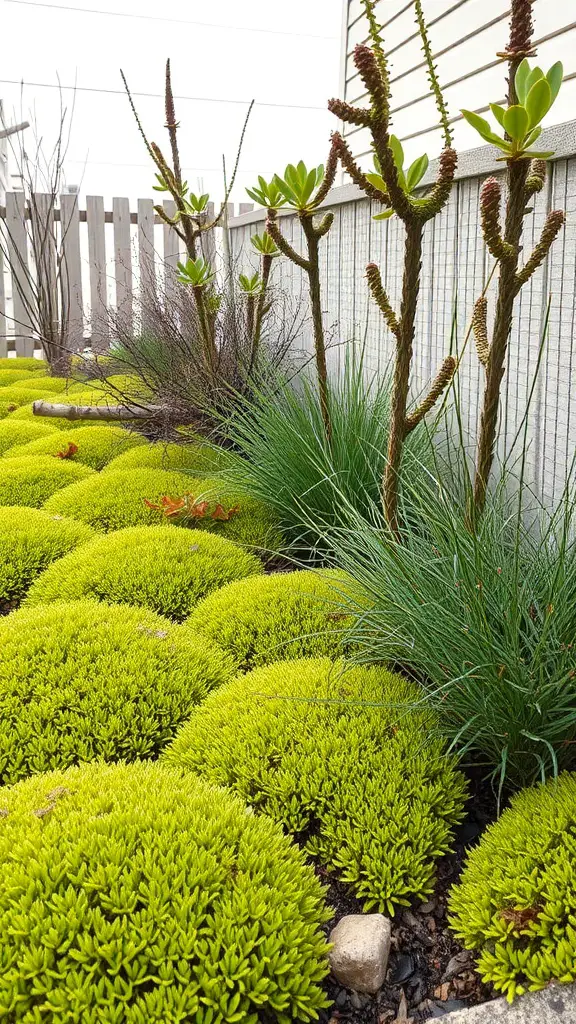
Ground covers are a great way to create a lush, green space without a lot of upkeep. The image shows a vibrant garden area filled with rounded patches of bright green ground cover. This type of planting can help reduce weeds and keep soil moist.
Using ground covers like these can transform a small garden into a low-maintenance paradise. They spread easily and fill in gaps, making your garden look full and inviting. Plus, they often require less watering and care than traditional plants.
In the image, you can also see some taller plants mixed in, adding height and interest. This combination of ground covers and taller plants creates a layered look that is visually appealing. It’s a smart way to make the most of limited space while keeping maintenance to a minimum.
Utilizing Fencing for Plant Support
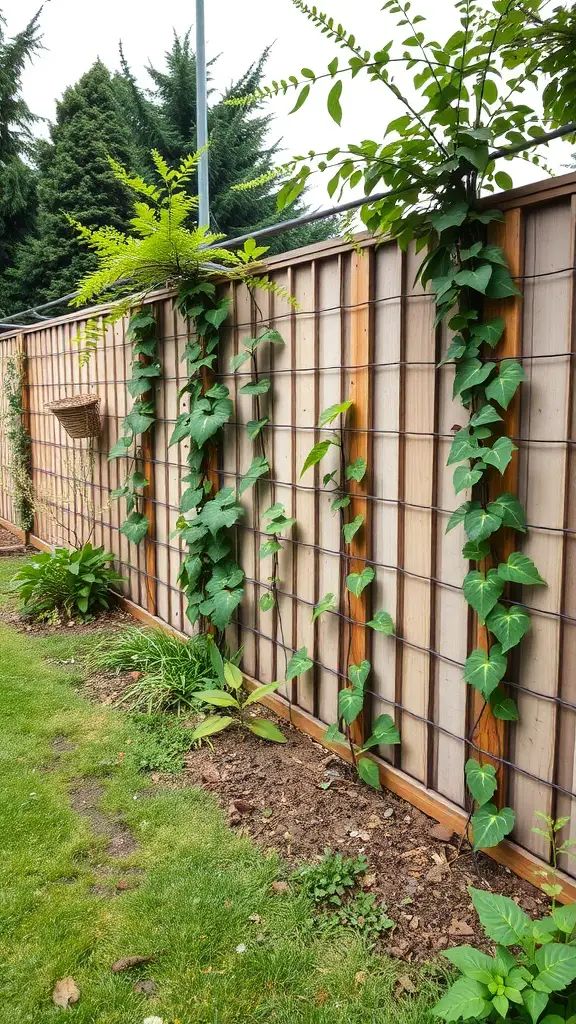
Fencing can be a great ally in your small garden. It offers a sturdy structure for climbing plants, helping them grow upward instead of outward. This not only saves space but also adds visual interest to your garden.
In the image, you can see a wooden fence adorned with climbing plants. The vines are reaching up, creating a lush green backdrop. This setup not only looks beautiful but also maximizes the use of vertical space.
Using fencing for plant support is simple. You can attach trellises or even wire to your fence. This allows plants like beans, peas, or flowering vines to thrive. The result is a vibrant display that enhances your garden’s charm.
Moreover, this method can improve air circulation around your plants, reducing the risk of disease. It’s a win-win for both aesthetics and plant health!
Utilizing Hanging Baskets
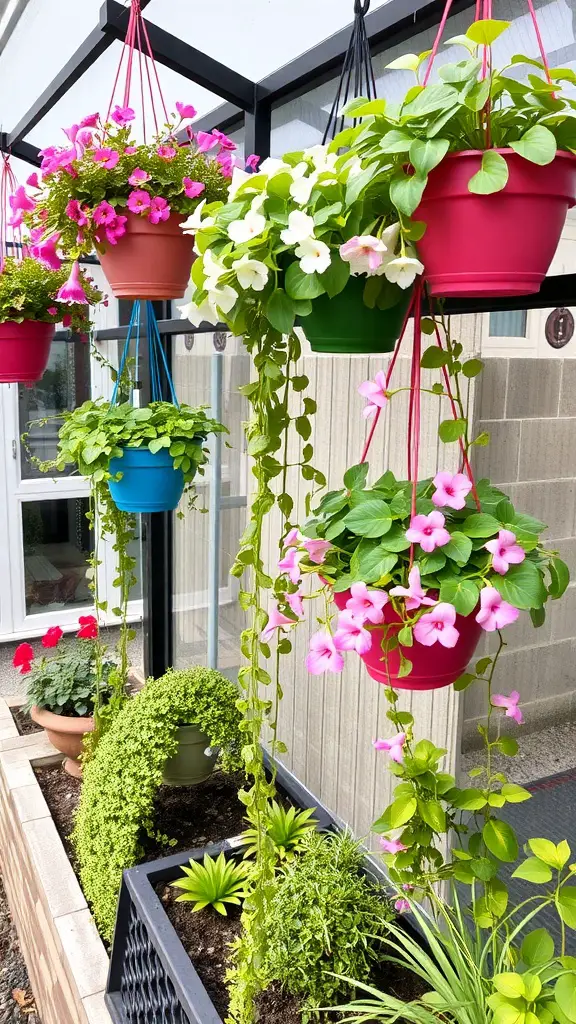
Hanging baskets are a fantastic way to add color and life to small gardens. They create vertical interest and can brighten up any space. In the image, you can see a delightful arrangement of vibrant flowers in various pots. The pink and white blooms stand out beautifully against the greenery.
These baskets can be placed in many locations, from patios to balconies. They don’t take up ground space, making them perfect for smaller areas. You can mix different plants to create a unique look. Consider using trailing plants alongside upright flowers for a lush effect.
Maintaining hanging baskets is simple. Regular watering and occasional feeding will keep your plants thriving. Make sure to choose plants that enjoy similar light and water conditions. This way, your hanging garden will flourish all season long!
Creating a Zen Garden
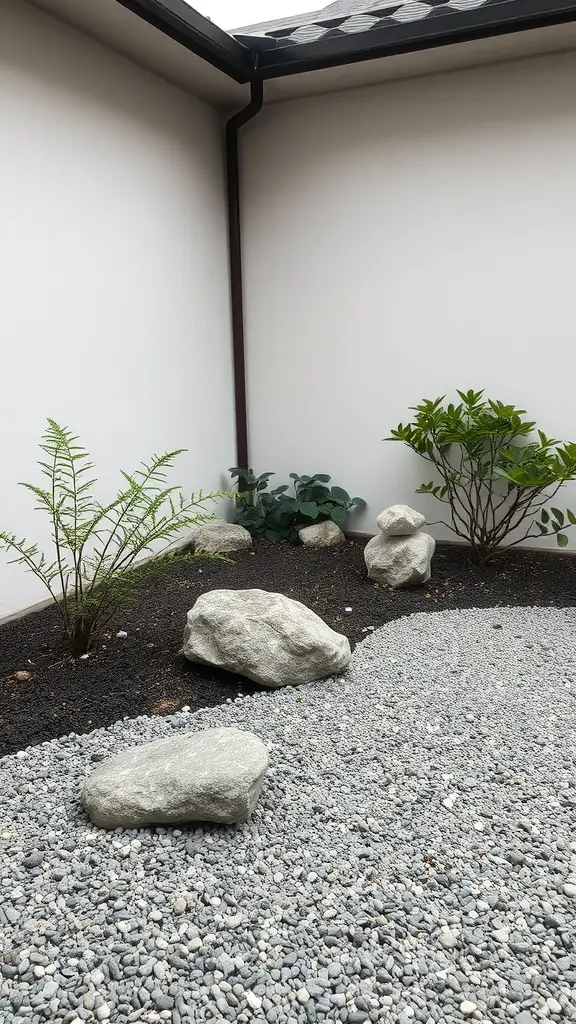
A Zen garden is a peaceful retreat that brings a sense of calm to any small space. The image shows a simple yet effective layout, featuring smooth stones and gravel. These elements create a tranquil environment that encourages relaxation and mindfulness.
The use of natural materials like rocks and plants adds to the serene vibe. The greenery, including ferns and other low-maintenance plants, offers a touch of life without overwhelming the space. This balance is key in Zen garden design.
Incorporating a Zen garden into your small garden ideas can transform a corner of your yard or patio into a meditative space. It’s not just about aesthetics; it’s about creating a spot where you can unwind and reflect.
Creating a Shade Garden
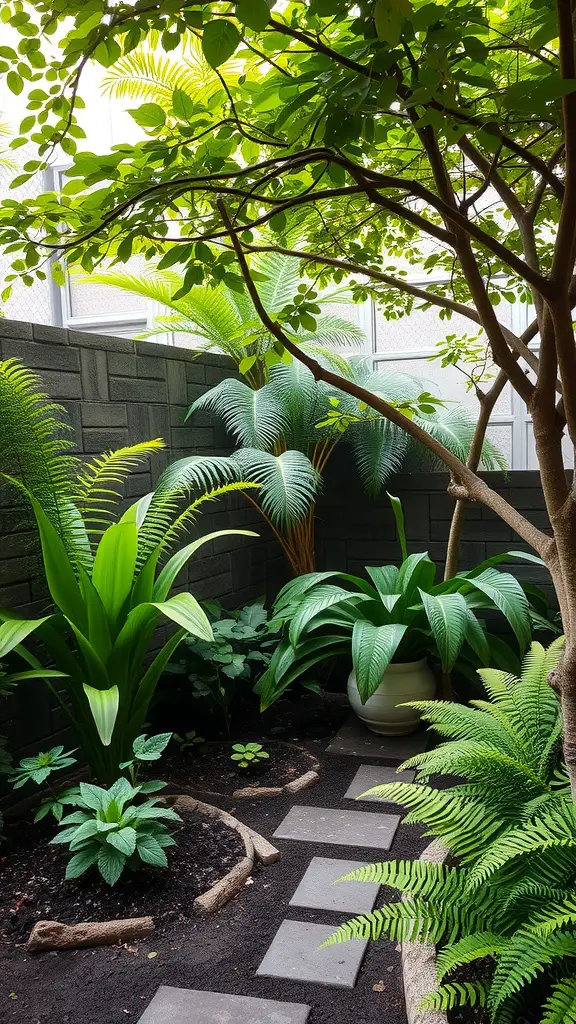
A shade garden can be a peaceful retreat filled with lush greenery. The image shows a cozy corner with various plants thriving in a shaded area. The tall tree provides a natural canopy, allowing other plants to flourish beneath it.
Using a mix of ferns and broad-leafed plants adds texture and depth. The pathway made of stones guides you through this green space, making it inviting and easy to navigate. You can see how the dark soil contrasts beautifully with the vibrant green leaves, creating a serene atmosphere.
When planning your shade garden, think about the types of plants that thrive in low light. Ferns, hostas, and shade-loving perennials are great choices. They not only survive but also add beauty to your garden. Incorporating different heights and shapes will make your garden visually interesting.
Don’t forget to include some decorative elements like stones or small garden ornaments to enhance the charm. A shade garden can be a lovely escape, perfect for relaxing or enjoying a good book.
Planting for Privacy in Small Spaces
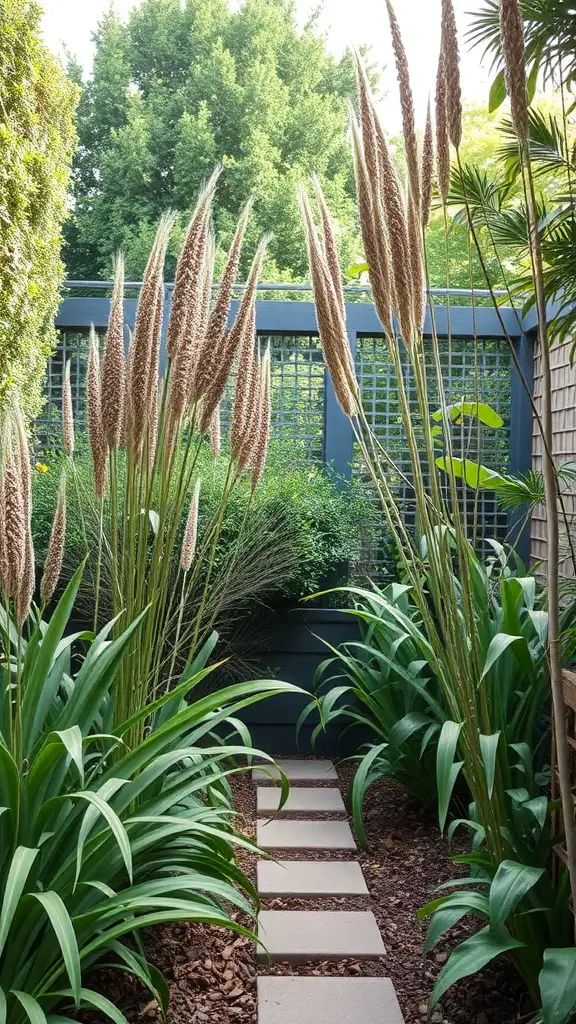
Creating a private retreat in a small garden can be both fun and rewarding. The image shows tall grasses and lush greenery flanking a stone pathway, providing a sense of enclosure. This setup not only adds beauty but also creates a cozy atmosphere.
Using plants for privacy is a smart choice. The tall grasses in the image act as natural screens, blocking out unwanted views while allowing light to filter through. This balance is key in small spaces where you want to feel open yet protected.
Consider incorporating similar plants in your garden. Opt for varieties that grow tall but don’t take up too much horizontal space. This way, you can enjoy privacy without sacrificing your garden’s overall size.
Another great idea is to mix in some evergreen shrubs. They provide year-round coverage and can be shaped to fit your space. Layering different heights and textures, like in the image, adds depth and interest to your garden.
Finally, don’t forget about the pathway! A well-defined path, like the one shown, guides visitors through your garden while enhancing the sense of privacy. It invites exploration while keeping the focus on your beautiful plants.
Creating a Cozy Seating Area
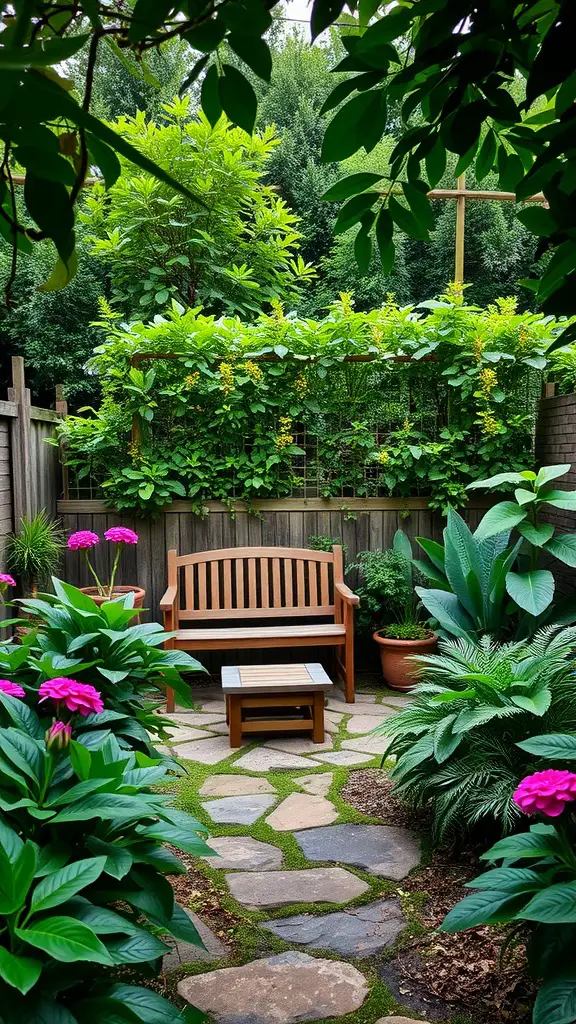
Creating a cozy seating area in your small garden can transform it into a perfect retreat. The image shows a lovely wooden bench surrounded by lush greenery and vibrant flowers. This setup invites you to sit back and enjoy the beauty of nature.
The stone pathway leading to the bench adds a charming touch. It guides you through the garden, making the space feel welcoming. The combination of plants and flowers creates a colorful backdrop, enhancing the overall appeal.
Consider adding cushions to the bench for extra comfort. A small table, like the one in the image, is great for holding drinks or books. This simple addition can make your garden feel more like an extension of your home.
Incorporating different heights of plants, as seen here, adds depth to the space. The taller plants provide privacy, while the flowers bring a pop of color. This balance makes the area feel cozy and inviting.
Building a Small Compost Area
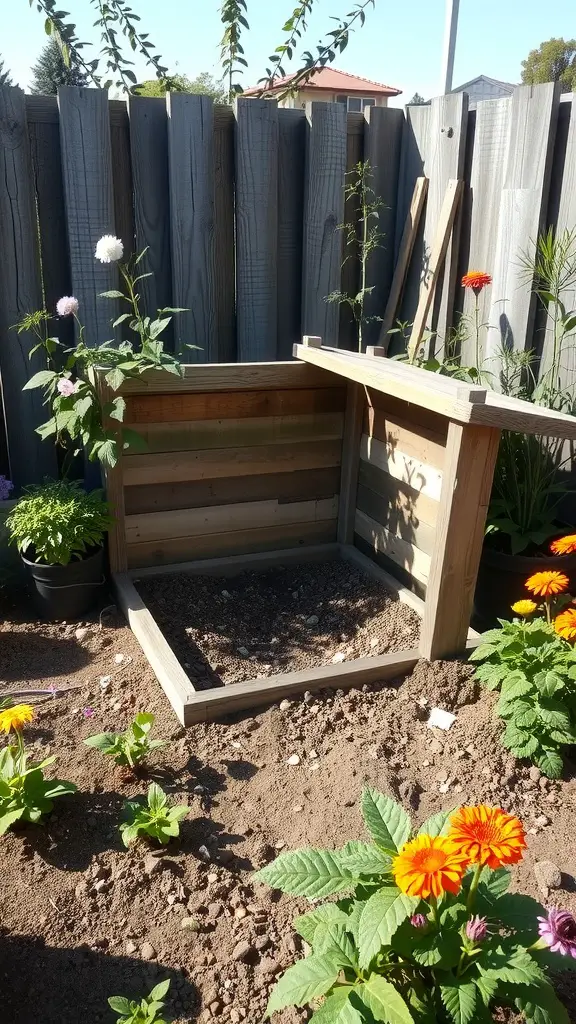
Creating a compost area in your small garden is a smart way to recycle kitchen scraps and yard waste. The image shows a simple wooden compost bin, which is perfect for small spaces. This setup allows for easy access and efficient composting.
To start, choose a corner of your garden that gets some sunlight. This helps speed up the composting process. The bin in the picture is made from wood, which is durable and blends well with the garden’s natural look.
When filling your compost bin, mix green materials like fruit peels and vegetable scraps with brown materials such as dried leaves and cardboard. This balance is key for healthy compost. Remember to turn the pile occasionally to aerate it, which helps break down the materials faster.
Having a compost area not only reduces waste but also enriches your garden soil. The compost produced can be used to nourish your plants, making your small garden even more vibrant and productive.


